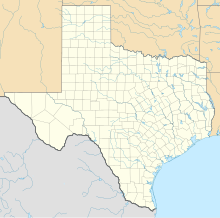Gault Site
Coordinates: 30 ° 54 '12.3 " N , 97 ° 39' 57.5" W.
The Gault Site is an archaeological site in Bell County , Texas , where artifacts from the Paleo-Indian and Archaic periods have been found. He is known for the limestones found in the 1990s with elaborate engravings , which are dated to the Clovis culture by an associated projectile point . In addition, the Gault Site contains datable finds from more than 13,500 years Before Present to contact with European settlers in a complete stratigraphy .
The site is located at a spring outlet on the now dried up Buttermilk Creek , which, as evidenced by traces of food preparation in higher stratigraphic layers, was frequently used by Indians between the beginning of the Archaic Period and the time shortly before contact with Europeans. The Buttermilk Creek is characterized by the fact that its course follows an outcrop of Edwards Chert , a flint particularly suitable for the production of stone tools . The name comes from Henry Gault, the owner of a farm to which the area belongs.
Digs
The entire Gault Site area covers an area of around 800 × 200 m along one edge of the site. As early as 1929, the anthropologist James E. Pearce of the University of Texas was digging at the Gault Site and found a middle , large-scale deposits of kitchen waste in which a multitude of early Indian artifacts were embedded. At that time they could not be fully classified and were recognized as belonging to the archaic period as knowledge progressed in the archeology of North America . In the following decades the archaeological site was badly destroyed by robbery excavations , the owner allowed anyone to dig for a small fee and to take all the finds. In 1998 the farm was sold, the new owner stopped the wild digging and invited Texas State University to carry out systematic excavations. In the immediate vicinity of the original site, archaeologists initially found ten stones on the surface of which fine lines were engraved with a pointed stone using the petroglyph technique. Systematic excavations later found eleven more engraved stones and a piece of bone with parallel lines.
Excavations took place from 1998 to 2002 and from 2007 to 2014. Gault Site has belonged to the non-profit organization The Archaeological Conservancy since 2007 and is operated by the Gault School of Archaeological Research in cooperation with Texas State University.
Finds
The 21 stones so far and the piece of bone with engraved lines are the most striking finds. The engravings are only partially visible, as the stones have developed lime crusts over time, which partially cover the engravings. Since both the original stone and the crusts consist of chemically identical limestone, no technique is known of how only the crusts could be removed so that the engravings could be exposed without destroying them. The engravings themselves are mostly straight, often parallel. The parallel bundles intersect single or multiple lines and form a rectangular or diamond-shaped pattern. In some cases straight lines are cut by curves, in one case it could be a stylized animal. In another case, there are several diamond-shaped elements at the end of straight and curved lines, giving the impression of flowers.
The pebbles were found along with four Clovis projectile points, one of which was so positioned between two of the stones that a later disturbance is considered unlikely and the stones can be dated via this association.
In 2011 artefacts were found just 250 m away in the so-called Buttermilk Creek Complex under a thin layer of Clovis, which could be identified as the ancestors of the Clovis culture and an age of 12,300 to 15,500 years. They are the oldest artifacts in America to date and prove that the tools of the Clovis culture were developed in America and were not brought back from Asia when America was settled.
literature
- Michael B. Collins, Thomas R. Hester et al .: Engraved Cobbles from Early Archaeological Contexts in Central Texas . In: Current Research in the Pleistocene , Volume 8, 1991, pp. 13-15
- Ashley K. Lembke, D. Clark Wernecke, Michael B. Collins: Early Art in North America: Clovis and Later Palaeoindian Incised Artfacts from the Gault Site, Texas (41BL323) . In: American Antiquity , Volume 80, Issue 1 (2015), pp. 113-133
- Michael B. Collins: The Gault Site, Texas, and Clovis Research . In: Athena Review , Vol. 3, No. 2, pp. 31–42 ( athenapub.com )
Web links
- Michael B. Collins: Gault Site. In: The Handbook of Texas Online. Texas State Historical Association (TSHA), 1999 ff (English, tshaonline.org ).
Individual evidence
- ^ A b Thomas A. Jennings, Michael R. Waters: Pre-Clovis lithic technology at the Debra L. Friedkin site, Texas: comparisons to Clovis through site-level behavior, technological trait-list, and cladistic analyzes . In: American Antiquity , Volume 79 (2014), pages 25-44
- ^ Ashley K. Lembke, D. Clark Wernecke, Michael B. Collins: Early Art in North America: Clovis and Later Palaeoindian Incised Artfacts from the Gault Site, Texas (41BL323) . In: American Antiquity , Volume 80, Issue 1 (2015), p. 117


